A Coupled 1D–3D Numerical Method for Buoyancy-Driven Heat Transfer in a Generic Engine Bay
Abstract
:1. Intoduction
2. Theoretical and Modeling Background
2.1. 3D Governing Equations of Buoyancy-Driven Flow
2.2. Heat Transfer
2.2.1. 1D Heat Conduction in the Solid Subdomain
2.2.2. Thermal Radiation
3. Physical Measurements
Experimental Setup and Procedure
4. Numerical Procedure
4.1. Computational Domain
4.2. 1D Model of Transient Heat Transfer in Engine Solids
4.3. 3D CFD Numerical Solver for the Fluid Flow and Heat Transfer
4.4. Description of 1D–3D Direct Coupled Approach
4.5. Results from Simulations of Steady-State Heat Transfer
5. Results and Discusssion
Results from Simulations of Transient Cool-Down
6. Concluding Remarks
Author Contributions
Funding
Acknowledgments
Conflicts of Interest
References
- Lu, P.; Gao, Q.; Liang, L.; Xue, X.; Wang, Y. Numerical Calculation Method of Model Predictive Control for Integrated Vehicle Thermal Management Based on Underhood Coupling Thermal Transmission. Energies 2019, 12, 259. [Google Scholar] [CrossRef]
- Wang, Y.; Gao, Q.; Zhang, T.; Wang, G.; Jiang, Z.; Li, Y. Advances in integrated vehicle thermal management and numerical simulation. Energies 2017, 10, 1636. [Google Scholar] [CrossRef]
- Muscio, A.; Mattarelli, E. Potential of Thermal Engine Encapsulation on Automotive Diesel Engines; SAE Technical Paper; SAE International: Detroit, MI, USA, 2005. [Google Scholar] [CrossRef]
- Minovski, B.; Lofdahl, L.; Gullberg, P. Numerical Investigation of Natural Convection in a Simplified Engine Bay; SAE Technical Paper; SAE International: Detroit, MI, USA, 2016. [Google Scholar] [CrossRef]
- Sweetman, B.; Schmitz, I.; Hupertz, B.; Shaw, N. Numerical Investigation of Vehicle Drive and Thermal Soak Conditions in a Simplified Engine Bay. SAE Int. J. Passeng. Cars Mech. Syst. 2017, 10, 433–445. [Google Scholar] [CrossRef]
- Franchetta, M.; Suen, K.; Williams, P.; Bancroft, T. Investigation into Natural Convection in an Underhood Model Under Heat Soak Condition; SAE Technical Paper 2005-01-1384; SAE International: Detroit, MI, USA, 2005. [Google Scholar] [CrossRef]
- Franchetta, M.; Bancroft, T.; Suen, K. Fast Transient Simulations of Vehicle Underhood in Heat Soak; SAE Technical Paper 2006-01-1606; SAE International: Detroit, MI, USA, 2006. [Google Scholar] [CrossRef]
- Davis, C. Investigation of Underhood Buoyancy driven Flow and Thermal Measurements in a Simplified Full Scale Underhood Engine Compartment with Open Enclosure. Master’s Thesis, Western Michigan University, Kalamazoo, MI, USA, 2009. [Google Scholar]
- Chen, K.; Johnson, J.; Merati, P.; Davis, C. Numerical Investigation of Buoyancy-Driven Flow in a Simplified Underhood with open Enclosure. SAE Int. J. Passeng. Cars Mech. Syst. 2013, 6. [Google Scholar] [CrossRef]
- Merati, P.; Davis, C.; Chen, K.H.; Johnson, J.P. Underhood Buoyancy Driven Flow—An Experimental Study. J. Heat Transf. 2011, 133, 1–9. [Google Scholar] [CrossRef]
- Yuan, R.; Sivasankaran, S.; Dutta, N.; Jansen, W.; Ebrahimi, K. Numerical investigation of buoyancy-driven heat transfer within engine bay environment during thermal soak. Appl. Therm. Eng. 2019, 164, 114525. [Google Scholar] [CrossRef]
- Truitt, R. Fundamentals of Aerodynamic Heating; Ronald Press Co.: New York, NY, USA, 1960. [Google Scholar]
- Wilcox, D.C. Turbulence Modeling for CFD, 2nd ed.; DCW Industries: La Canada, CA, USA, 2006. [Google Scholar]
- Incropera, F.P.; Dewitt, D.P.; Bergman, T.L.; Lavine, A.S. Fundamentals of Heat and Mass Transfer; John Wiley and Sons: New York, NY, USA, 2007. [Google Scholar]
- Lauriat, G.; Desrayaud, G. Effect of surface radiation on conjugate natural convection in partially open enclosures. Int. J. Therm. Sci. 2005, 45, 335–346. [Google Scholar] [CrossRef]
- Miroshnichenko, I.V.; Sheremet, M.A.; Mohamad, A.A. Numerical simulation of a conjugate turbulent natural convection combined with surface thermal radiation in an enclosure with a heat source. Int. J. Therm. Sci. 2016, 109, 172–181. [Google Scholar] [CrossRef]
- Modest, M.F. Radiative Heat Transfer, Series in Mechanical Engineering; McGraw-Hill: New York, NY, USA, 1993. [Google Scholar]
- Siegel, R. Thermal Radiation Heat Transfer; Hemisphere Pub. Corp: Washington, DC, USA, 1992. [Google Scholar]
- StarCCM+ User Guide v.11.04. Available online: http://www.cd-adapco.com/products/star-ccm/documentation (accessed on 26 August 2019).
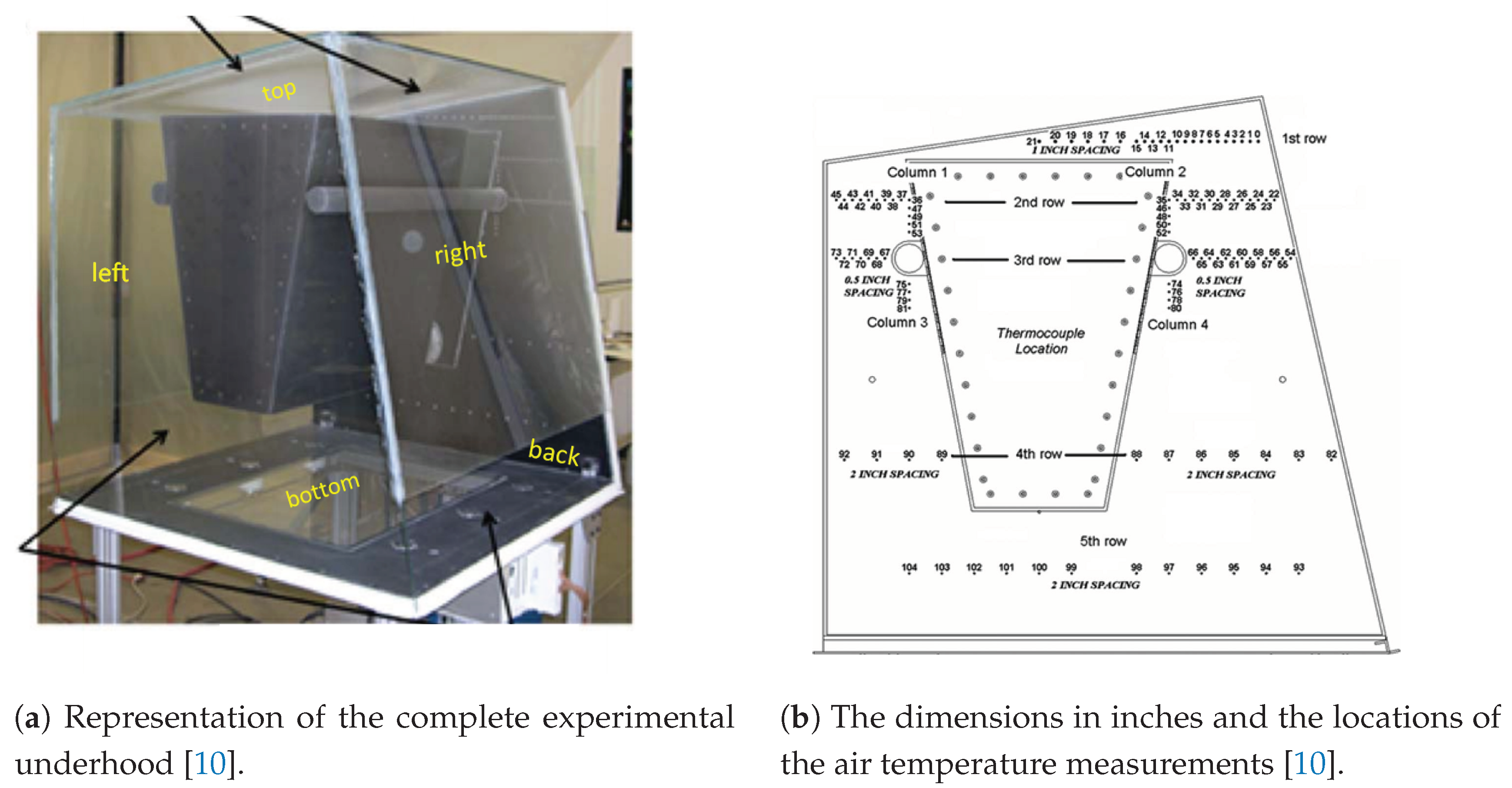
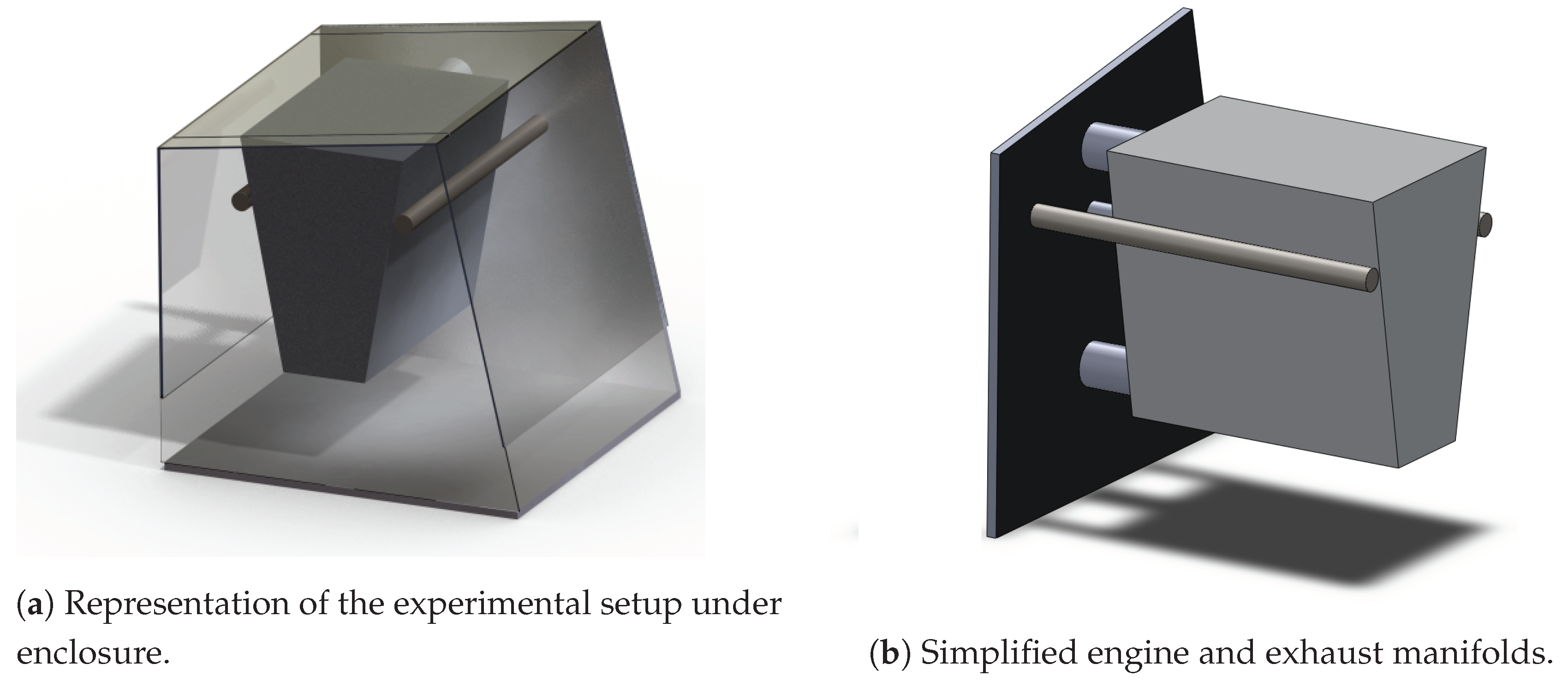
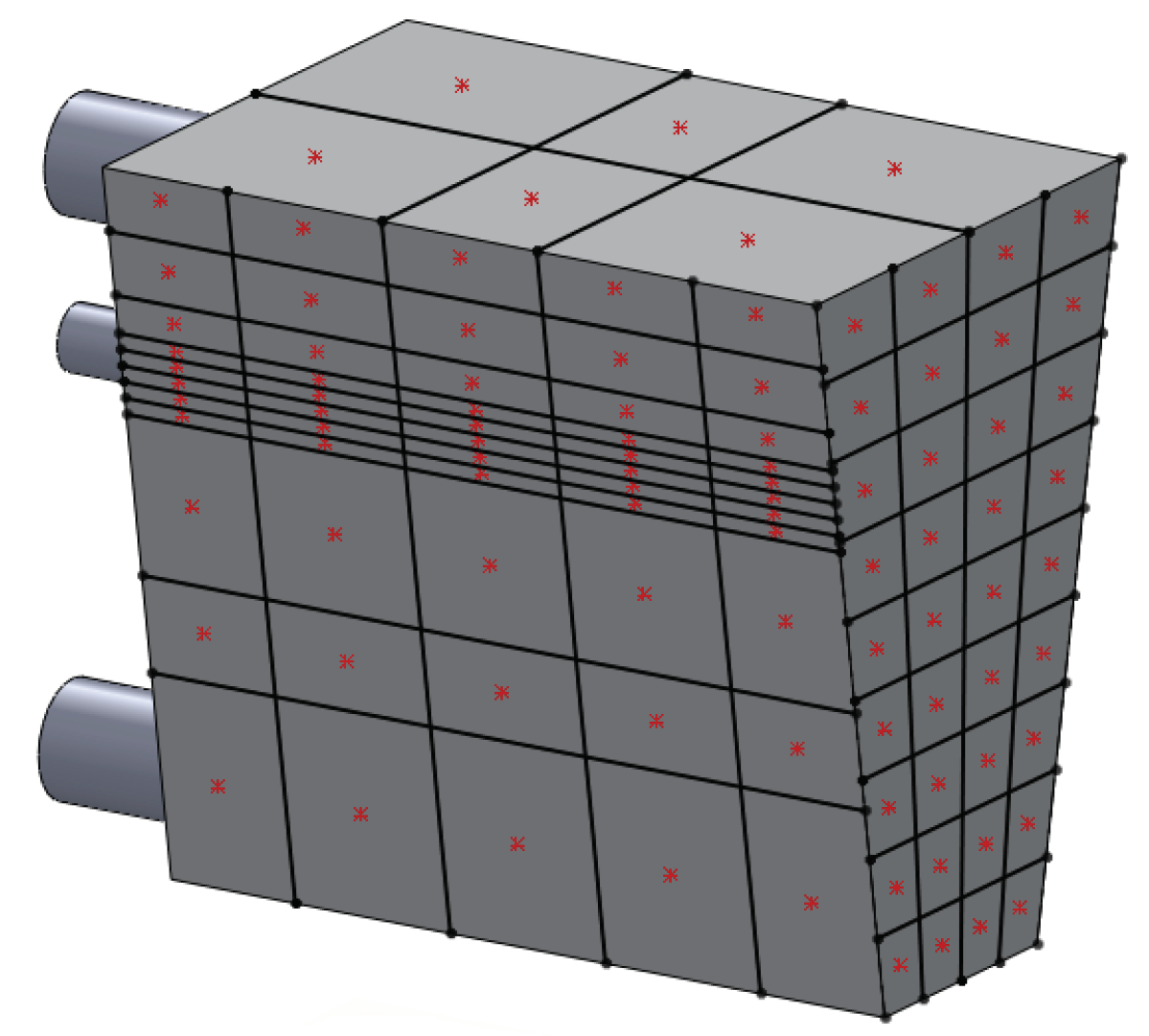
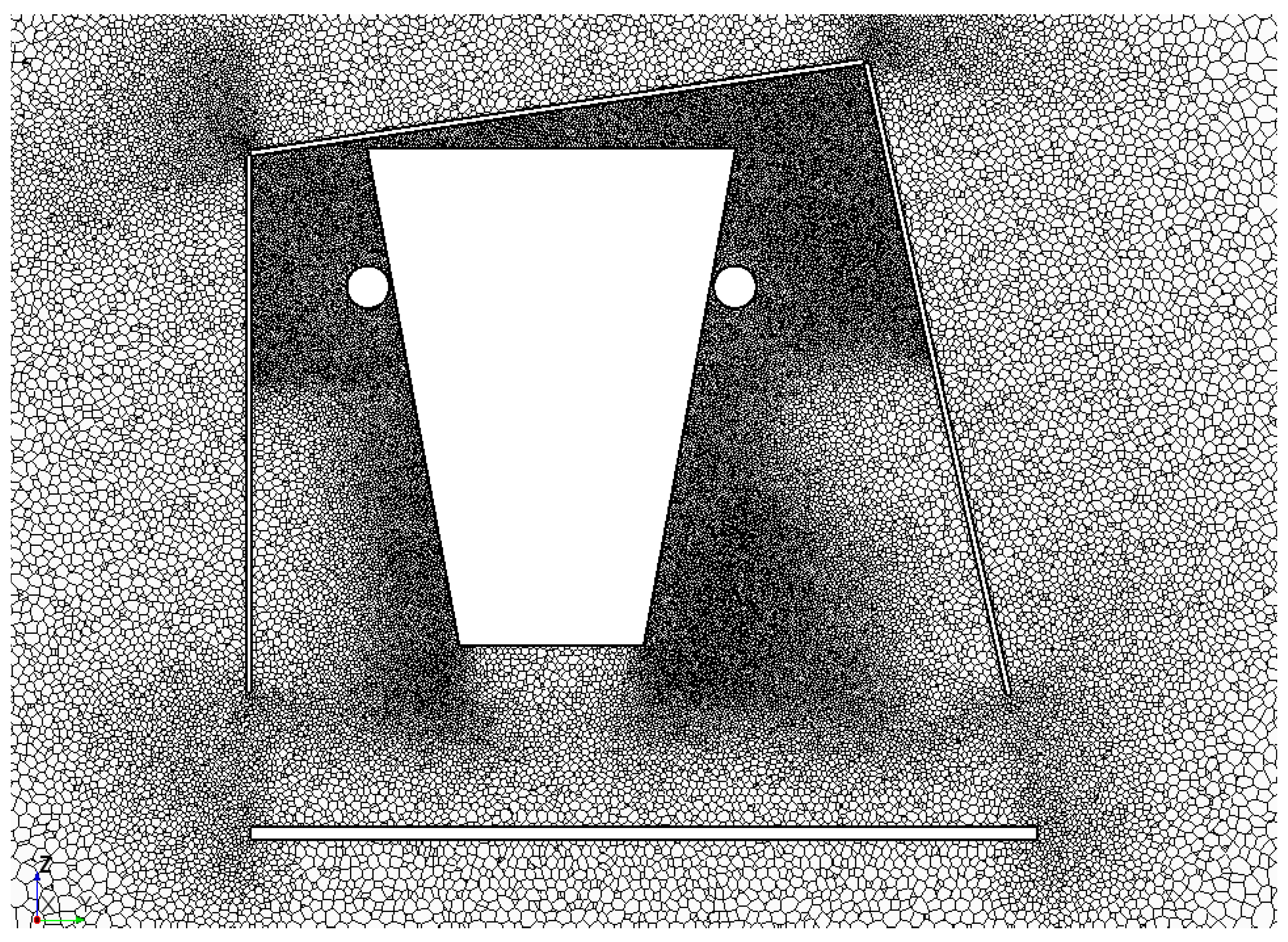
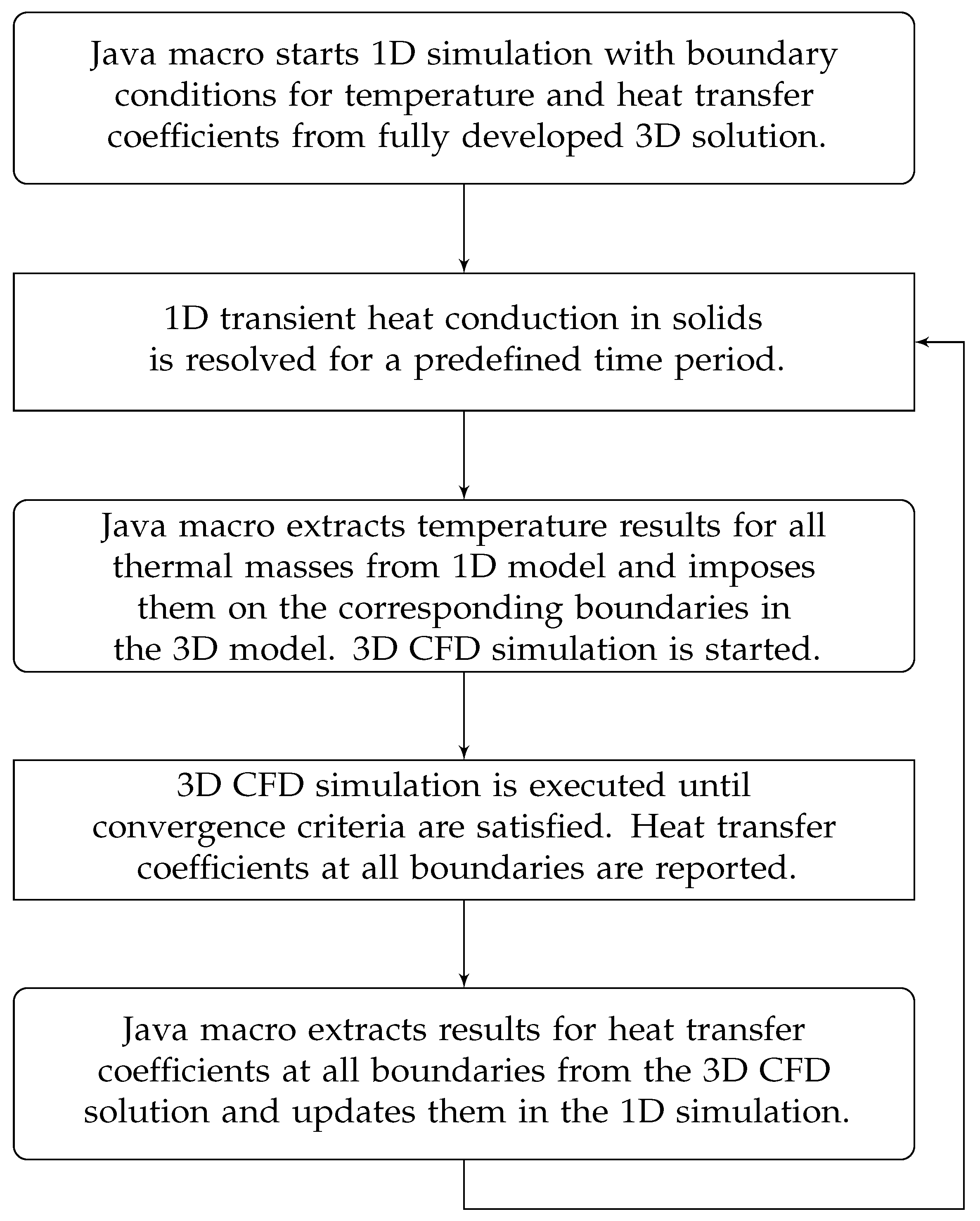
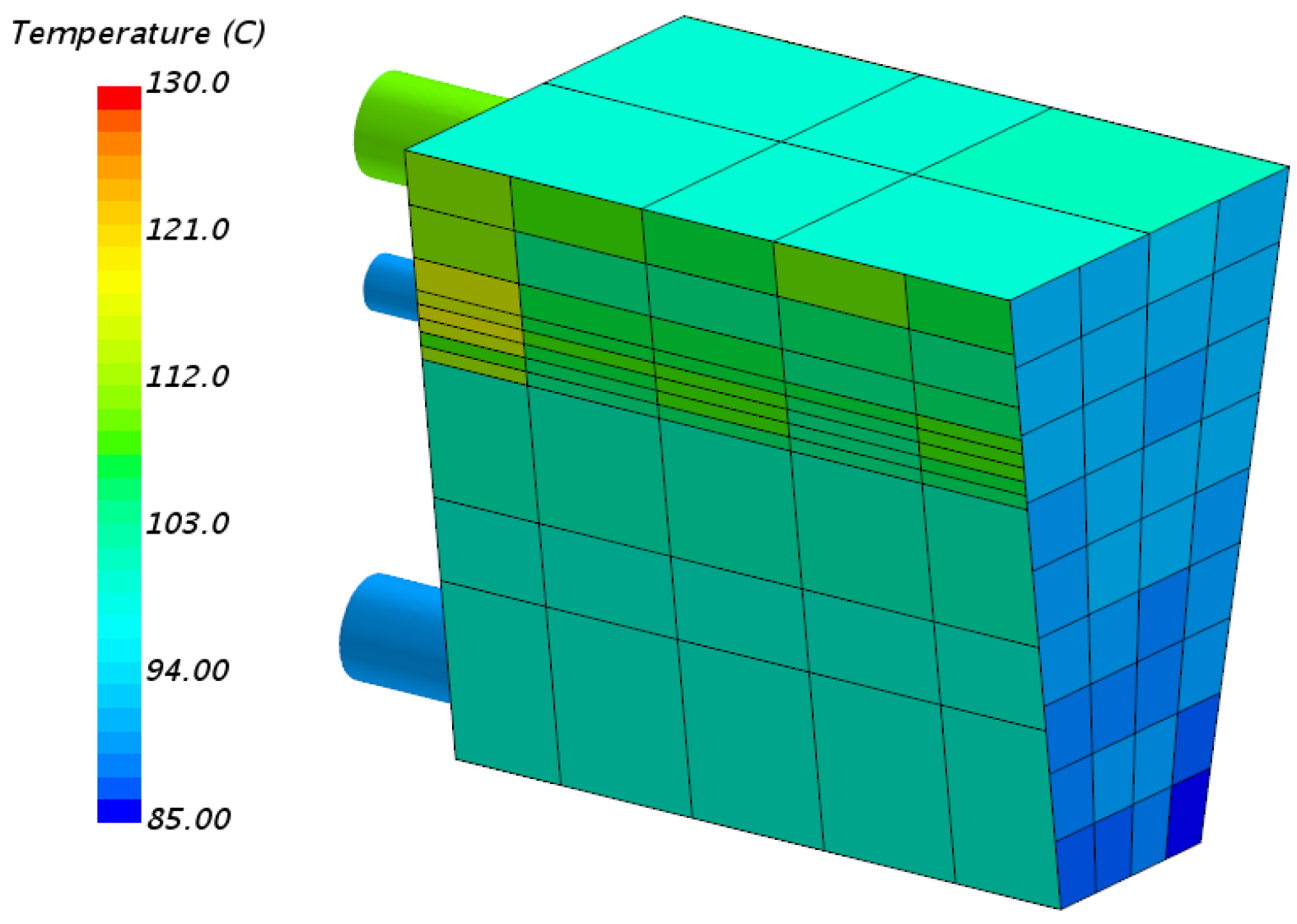
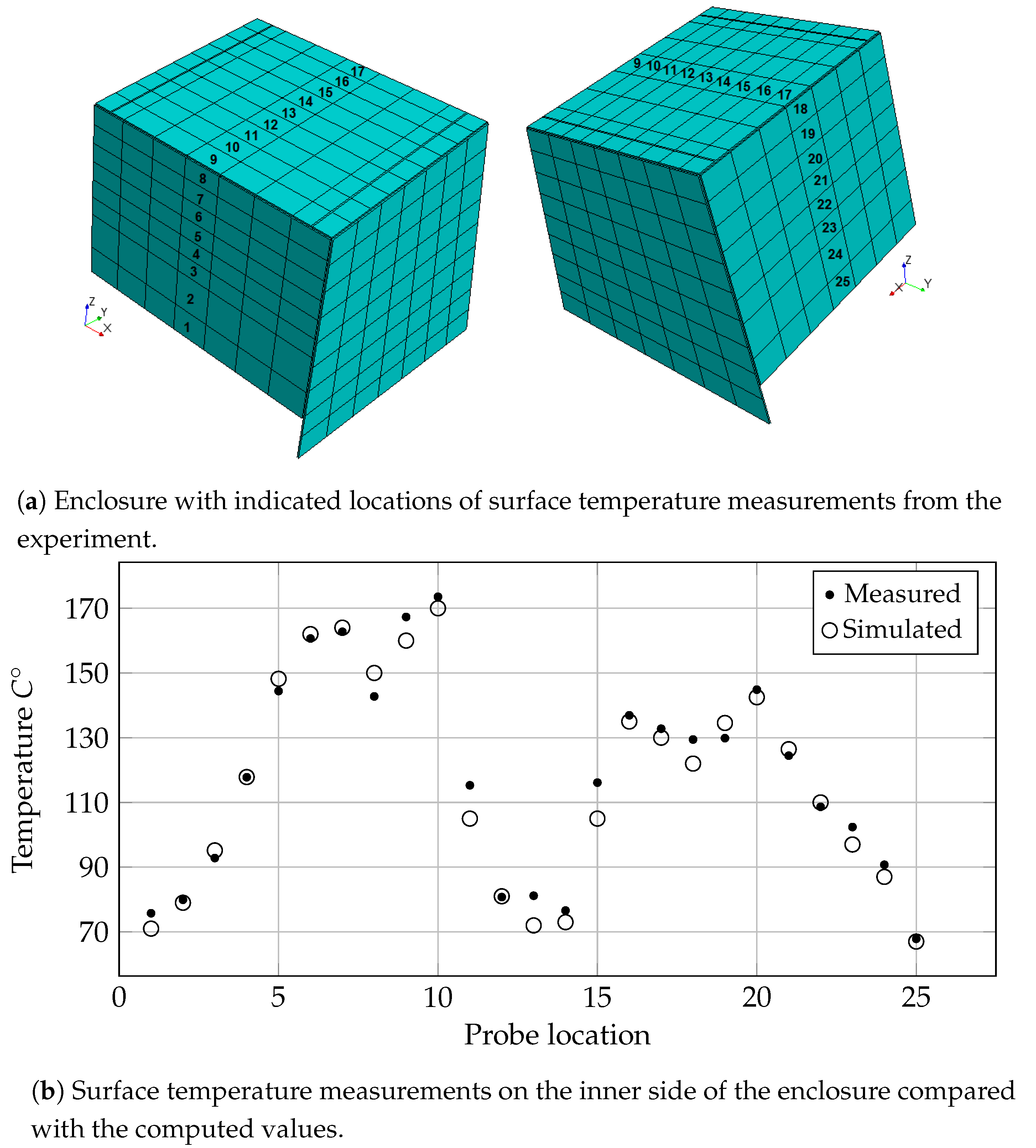

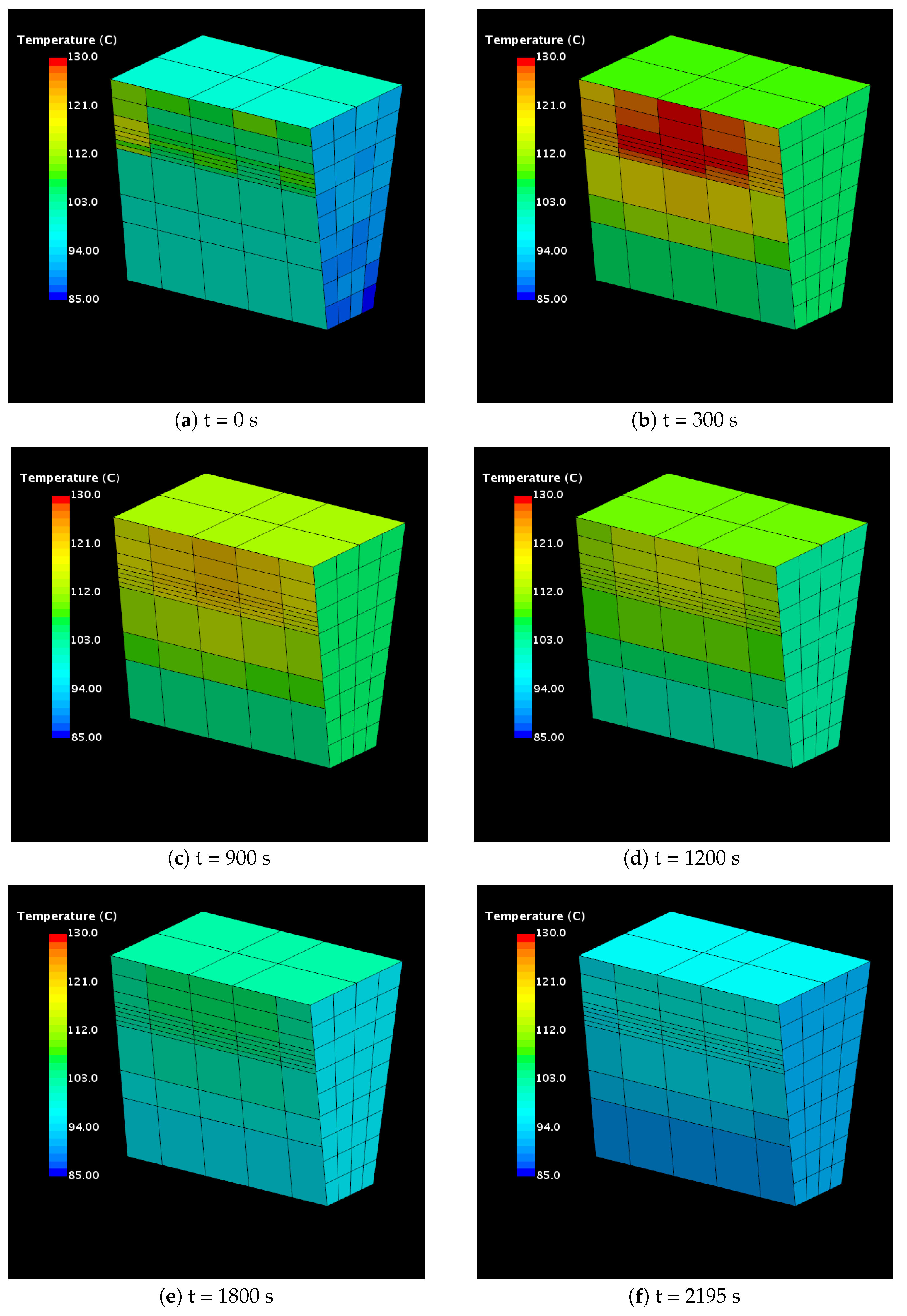
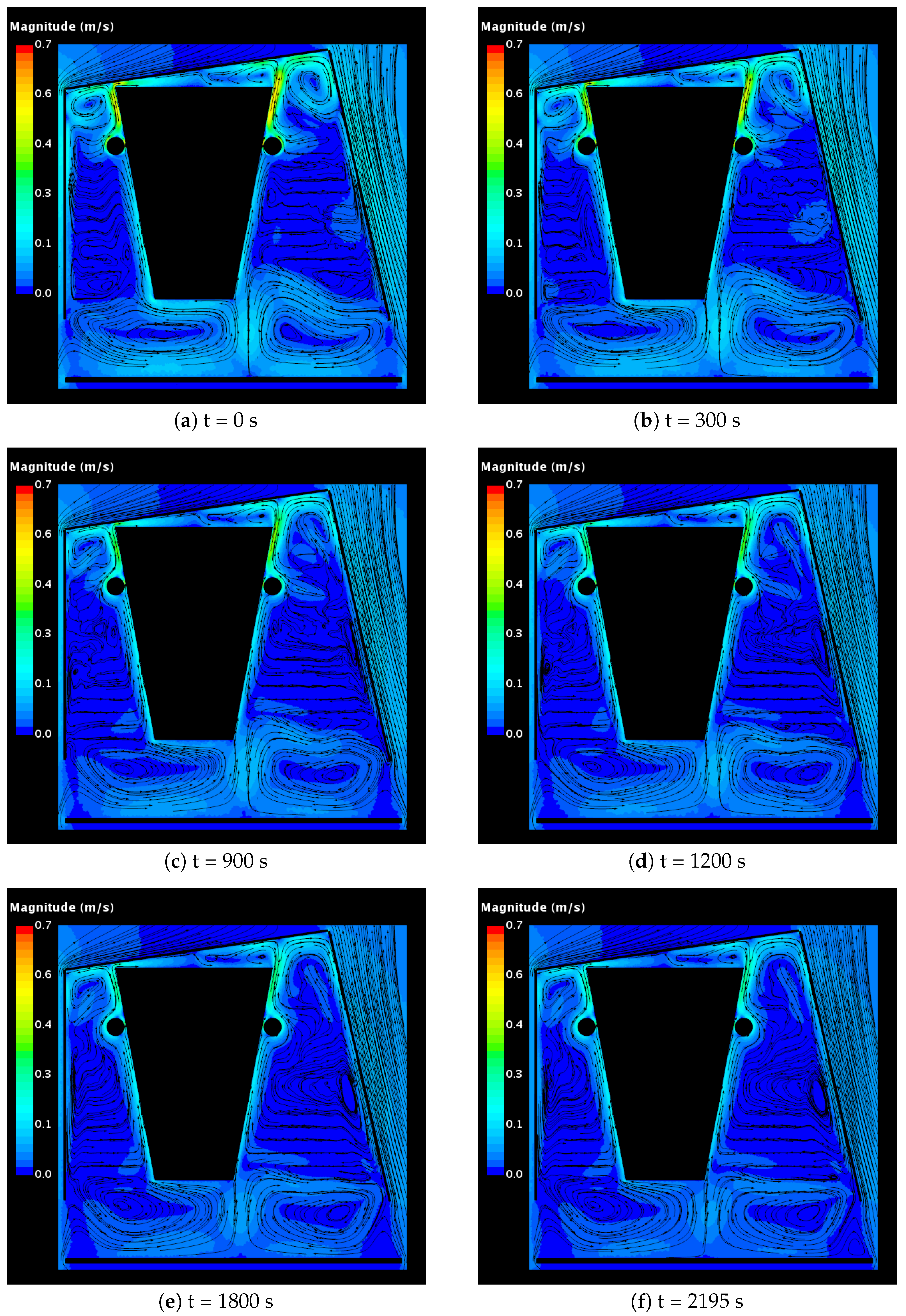

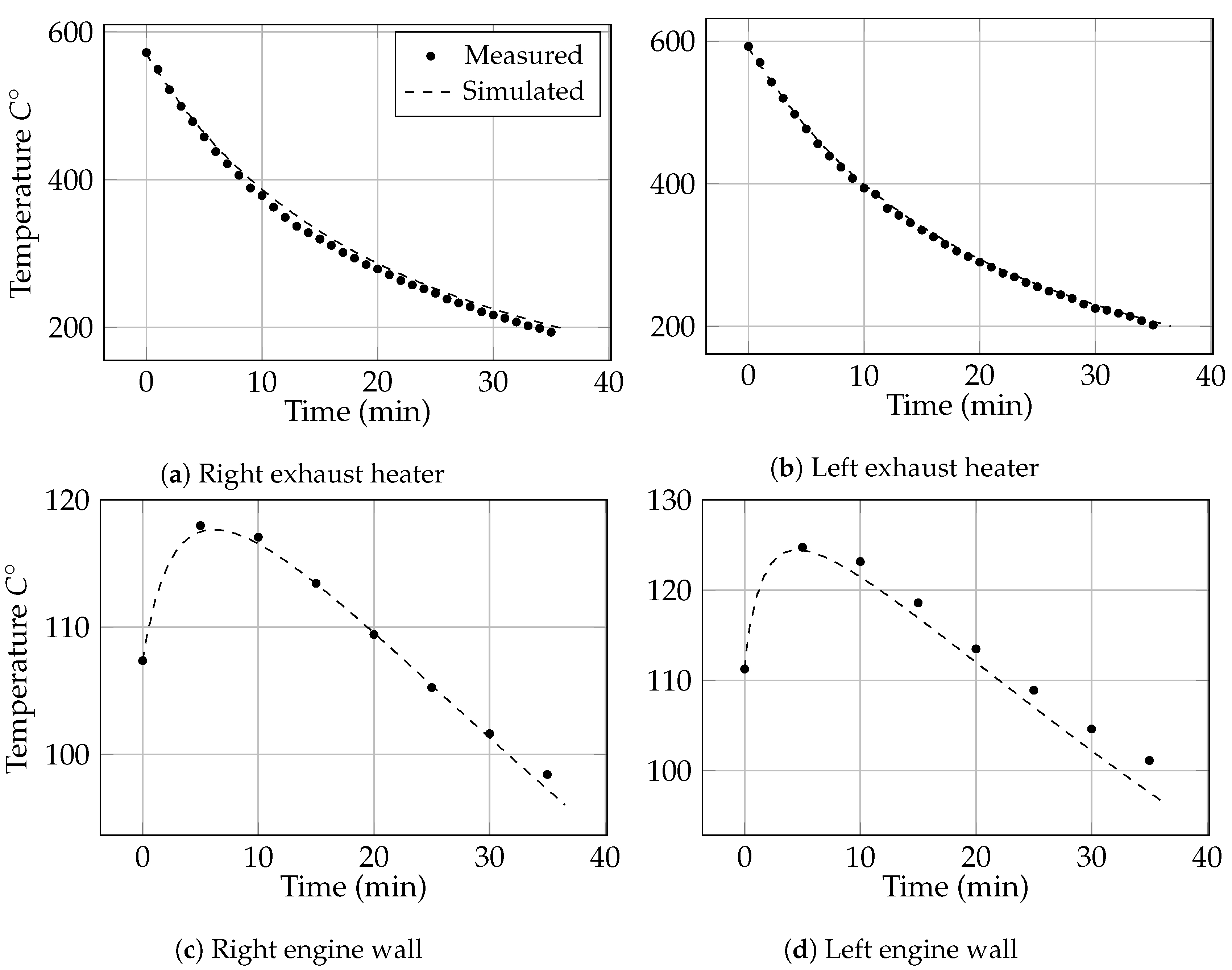
| (C) | (Pa · s) | (W/m · K) | (K) | (K) |
|---|---|---|---|---|
| 0 | 0.00001716 | 0.02614 | 111 | 194 |
| Material | Part | Number of Units | Mass (g) |
|---|---|---|---|
| Aluminum | Engine side wall | 5 | 137 |
| 5 | 132 | ||
| 5 | 82 | ||
| 25 | 35 | ||
| 5 | 347 | ||
| 5 | 209 | ||
| 5 | 450 | ||
| Engine top | 1 | 5796 | |
| Engine bottom | 1 | 2884 | |
| Engine front | 1 | 2939 | |
| Engine back | 1 | 2939 | |
| Steel | Exhaust manifold | 1 | 6750 |
| Thermal Conductivity (W/m·K) | Specific Heat (J/kg·K) | |||
|---|---|---|---|---|
| T (C) | Aluminum | Steel | Aluminum | Steel |
| 27 | 237 | 60.5 | 903 | 434 |
| 127 | 240 | 56.7 | 949 | 487 |
| 327 | 231 | 48 | 1033 | 559 |
| 527 | 216 | 39.2 | 1146 | 685 |
© 2019 by the authors. Licensee MDPI, Basel, Switzerland. This article is an open access article distributed under the terms and conditions of the Creative Commons Attribution (CC BY) license (http://creativecommons.org/licenses/by/4.0/).
Share and Cite
Minovski, B.; Löfdahl, L.; Andrić, J.; Gullberg, P. A Coupled 1D–3D Numerical Method for Buoyancy-Driven Heat Transfer in a Generic Engine Bay. Energies 2019, 12, 4156. https://doi.org/10.3390/en12214156
Minovski B, Löfdahl L, Andrić J, Gullberg P. A Coupled 1D–3D Numerical Method for Buoyancy-Driven Heat Transfer in a Generic Engine Bay. Energies. 2019; 12(21):4156. https://doi.org/10.3390/en12214156
Chicago/Turabian StyleMinovski, Blago, Lennart Löfdahl, Jelena Andrić, and Peter Gullberg. 2019. "A Coupled 1D–3D Numerical Method for Buoyancy-Driven Heat Transfer in a Generic Engine Bay" Energies 12, no. 21: 4156. https://doi.org/10.3390/en12214156
APA StyleMinovski, B., Löfdahl, L., Andrić, J., & Gullberg, P. (2019). A Coupled 1D–3D Numerical Method for Buoyancy-Driven Heat Transfer in a Generic Engine Bay. Energies, 12(21), 4156. https://doi.org/10.3390/en12214156






